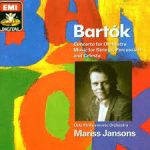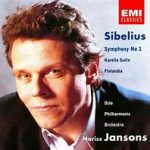The EMI Recordings- 1987-1997|Part Five
The year 1990
Bartok and Sibelius
In my last blog post, My Musical Career | Part Thirty-Nine, I wrote a little about our recordings for the year 1990, but confined myself to a broader overview of the happenings of that particular season. In this blog post, I can happily go into more detail regarding our recording sessions for that season. I mentioned in an earlier blog post that EMI had gone from a three recording a year format to a two recording a year one. This turned out to fit our schedule nicely, as we used the time that we would normally have used for a third EMI recording to record music of contemporary Norwegian composers. If memory serves me correctly, I believe we recording music of Olav Anton Thommesen in early January. EMI and the orchestra administration (including Mariss Jansons) had already decided on recordings of the music of Bela Bartok and Jean Sibelius for the year 1990. Bartok’s Concerto for Orchestra and Music for Strings, Percussion and Celesta were scheduled for late January, and Sibelius’s First Symphony, Karelia Suite and Finlandia were scheduled for September. Both composers were (and still are) among my favorites and wrote very demanding parts for the timpani. Bartok wrote in a very forward-looking style, using every advantage of the pedal-style timpani, whereas Sibelius wrote in a more late Romantic style, particularly in the aforementioned works. Nonetheless, his writing for the instrument even then required a highly developed technique in order to bring them off properly, and later works required even more technique. This is a main reason why I enjoy their music so much.
Bartok
As I mentioned earlier, the Concerto for Orchestra and the Music for Strings, Percussion and Celesta were chosen for the late January recording sessions. The Music for Strings, Percussion and Celesta was written in the 1930s for the anniversary of the Basel Chamber Orchestra and Paul Sacher. It is one of the more difficult, but at the same time most satisfying works to play. The timpani part (as in all Bartok) requires the highest degree of rhythm, intonation and touch. The timpani part is exposed like never. The Concerto for Orchestra dates from 1943 and was written as a commission from the Koussevitzky Foundation and premiered in 1944 with the Boston Symphony Orchestra under the direction of Serge Koussevitzky, the man who was responsible for its commissioning. It was revised in 1945, shortly before Bartok died. He added a longer ending to the work, and it is this version that we recorded.
The recording team for these sessions was headed once again by John Fraser, who except for one later recording became our regular producer, and the recording engineer was Mar Vigars. The recording venue was, as usual, our problematic Oslo Konserthus. If memory serves correctly, we rehearsed and played the Concerto in as part of a regular concert series. The Music for Strings, Percussion and Celesta had been played in concert the previous season and had its own rehearsal before being committed to disc.
I prepared thoroughly for these recordings, even more than my usual preparation for concerts, which was pretty thorough. I decided to use the Hingers for the recordings. I used the four for the Music for Strings, Percussion and Celesta, and also for the Concerto for Orchestra, but for the fourth movement, I brought in the 24 inch Light Metropolitan B as I was not happy with the e on the 22 and half inch Hinger. For mallets, I used a mixture of Teahan-Hinger knockoffs – particularly for the slow movements of both works, and Feldman medium hard and hard mallets.
The recording sessions went well enough. They were intense, as this music requires intense concentration all the time. One cannot let one’s guard down for a minute and I do remember that we had recorded each work twice and then “cut and pasted” what needed to be fixed. For all the work and preparation, I found the final result (when released later on) to be very good, but there were a couple of things (mainly in the first movement of the Concerto and the end of the Music for Strings that could have had better editing). Also, If I had to do it over again, I would have not used the Light 24 inch as it had a Remo hazy head, the Hingers had calf. The sound from that drum was brighter than the others. Well, as the saying goes, you live and learn. NB!I could not find a YouTube link to the Bartok works. It is available on Amazon if you’re curious.
Sibelius
The Sibelius sessions were scheduled for just after our return from Salzburg, in early September. The Karelia Suite, Finlandia and Symphony No. 1 were scheduled to recorded. The recording team for these sessions was different. David Murray (who produced our first three EMI recordings) was back along with
Mike Clements. It was a bit like old times. Venue was the same, and even though the First Symphony was in the orchestra’s “DNA” – having played it so many times, it was worked up in concert. I’m not sure about the fillers, though. Those were short and were also familiar enough to the orchestra for them to have had their own rehearsal. I decided to continue using the Hingers, and I am glad I did as they really sounded good and the heads were in peak condition. For mallets I used mainly Feldman generals, medium hards and the red hards, with the Hinger wood-shafted generals, depending upon the work being recorded. In general, I always went one shade harder for recordings – sometimes even two. It was fiendishly difficult to get a good result from the Konserthus acoustics, and I wish I had the confidence of a Kurt-Hans Goedicke to insist on better miking. However, things turned out pretty good on these sessions.
When one hears the recordings nowadays, one will notice Jansons’s interpretive markings. He did this to clarify and to make things balance. If played as written, the First Symphony can seem muddy. This is where harder mallets and a strong technique come in handy. The first movement is a case in point. With the articulations on the low F sharp (and later on the B), one must be in control and not let them get too loud too soon. I used the Feldman blues (medium hard) for this movement. In the scherzo, the timpani part plays the motto on two notes c, and G. The motto actually goes c,c,c,c,b-flat-c, G. Well, having studying with Dan Hinger who recorded the work in 1960 with the Philadelphia and Eugene Ormandy and reflecting on his interpretation, I decided to incorporate it into my performances, and I did so for this recording as well. When I first played the work in college, I added a little crescendo-diminuendo (wrongly), for which I was criticized, and rightly so. Since then, and in this recording, I hammered it out as the composer indicated and felt a lot better about it. The only thing that bothered me, and still does (just a little) is that I have to use three drums – 25 inch for the c; 28 inch for the B flat, and 31 inch for the G. I like the larger drums for G and c –bigger sound and easier to articulate certain things. However, in this instance it worked out well enough. I used the Feldman red hards for the scherzo. Finlandia is another tough nut to record. If you were take the dynamics literally, one would run out of steam real fast. Those long e-flat rolls have to be balanced, and don’t forget the articulations! I used a pair of Teahan bamboo shafted mallets for Finlandia, and I am glad that I did, because they had the right weight and gave a full weight to this piece. One of the critics felt that it was too much, but I disagree.
All in all, it was a fun series of sessions and I still enjoy the results!
Here are some YouTubelinks to the symphony!
Enjoy!



Recent Comments